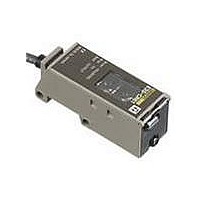E3S-CR11 Omron, E3S-CR11 Datasheet - Page 11

E3S-CR11
Manufacturer Part Number
E3S-CR11
Description
Industrial Photoelectric Sensors POLAR RETROREFLECTIV
Manufacturer
Omron
Type
Long Range Metal Body Sensorr
Series
E3S-Cr
Specifications of E3S-CR11
Features
Mutual interference protection
Height
29.5 mm
Length
50 mm
Maximum Operating Temperature
+ 55 C
Minimum Operating Temperature
- 25 C
Operating Supply Voltage
10 V to 30 V
Width
40.4 mm
Sensing Distance
3000 mm
Output Configuration
NPN or PNP
Sensing Range
0m To 3m
Output Current
100mA
Supply Voltage Range Dc
10V To 30V
Sensor Housing
Rectangular
Sensor Input
Optical
Sensing Range Max
3m
Switch Terminals
Wire Leaded
Svhc
Bis (2-ethyl(hexyl)phthalate) (DEHP) (15-Dec-2010)
Output Type
NPN / PNP Selectable
Response Time
1ms
Svhc (secondary)
Benzyl Butyl Phthalate (BBP) (15-Dec-2010)
Rohs Compliant
Yes
Connector Type
2m Cable
Current Consumption
40mA
External Depth
50mm
External Length / Height
23mm
External Width
20.4mm
Ip/nema Rating
IP67
Sensing Method
Retroreflective, Polarized
Sensing Object
Mirror
Sensing Light
Red
Mounting Type
Bracket Mount, Horizontal
Current - Supply
40mA
Voltage - Supply
10 V ~ 30 V
Package / Case
Module, Pre-Wired
Lead Free Status / RoHS Status
Lead free / RoHS Compliant
Lead Free Status / RoHS Status
Lead free / RoHS Compliant, Lead free / RoHS Compliant
Available stocks
Company
Part Number
Manufacturer
Quantity
Price
Company:
Part Number:
E3S-CR11-M1J
Manufacturer:
PIR
Quantity:
8 460
E3S-C
If reflective Photoelectric Sensors are installed side by side, each
reflective Photoelectric Sensor may be influenced by the light
emitted from the other Photoelectric Sensors.
The fuzzy mutual interference prevention function of the E3S-C en-
ables the E3S-C to monitor any light interference for a certain period
before the E3S-C starts emitting light so that the E3S-C can retrieve
the intensity and frequency of the light interference as data. Using
this data, the E3S-C estimates with fuzzy inference the risk of the
malfunctioning of the E3S-C and controls the timing of the E3S-C’s
light emission.
Unlike conventional photoelectric sensors, the variation in the sensitivity of E3S photoelectric sensors is minimal. This means the sensitivity
can be adjusted on only a single photoelectric sensor, and then the adjustors on the other photoelectric sensors can be set to the same scale
position. There is no need to adjust the sensitivity of each photoelectric sensor individually.
Sensing
condition
Sensitivity
adjustor
Indicators
Procedure
Fuzzy Mutual Interference Prevention Function
Sensitivity Adjustment (Reflective Sensors)
Item
Locate a sensing object at the
sensing distance, set the sensitivity
adjustor to the minimum scale
position, and gradually increase
sensitivity by turning the sensitivity
adjustor clockwise until the incident
light indicator (red LED) is ON.
Position A is where the indicator has
turned ON. Regard the maximum
scale position as Position A if the
indicator does not turned ON at full
sensitivity.
OFF
Photoelectric sensor
STABILITY
(green)
Min.
A
Position A
ON
Max.
LIGHT
(red)
Remove the sensing object and turn
the sensitivity adjustor clockwise until
the E3S-C detects the background
object and the incident light indicator
(red LED) is lit. The moment the red
light indicator is lit, stop turning the
sensitivity adjustor, the position of
which is point B. Turn the sensitivity
adjustor counterclockwise to decrease
the sensitivity until the red light
indicator is OFF. The moment the red
light indicator is OFF, stop turning the
sensitivity adjustor, the position of
which is point C.
If there is no background object, point
C is where the sensitivity adjustor is
set to maximum.
OFF
Photoelectric sensor
STABILITY
(green)
Min.
Position B
When the risk is low:
The E3S-C waits until there is no light interference and emits light.
When the risk is high:
The E3S-C emits light between each light interference moment.
OFF
Light interference
Emission pattern
Light interference
Emission pattern
C
Max.
B
LIGHT
(red)
---
Set the sensitivity indicator to the
position between Positions A and C
(in some cases, Positions A and C are
opposite of the above example). The
photoelectric sensor will then work
normally if the stability indicator
(green) is lit with and without the
sensing object. If it is not lit, stable
operation cannot be expected, in
which case a different sensing
method must be applied.
OFF
Min.
STABILITY
(green)
A
Setting
ON
C
Max.
LIGHT
(red)
E3S-C
11



















